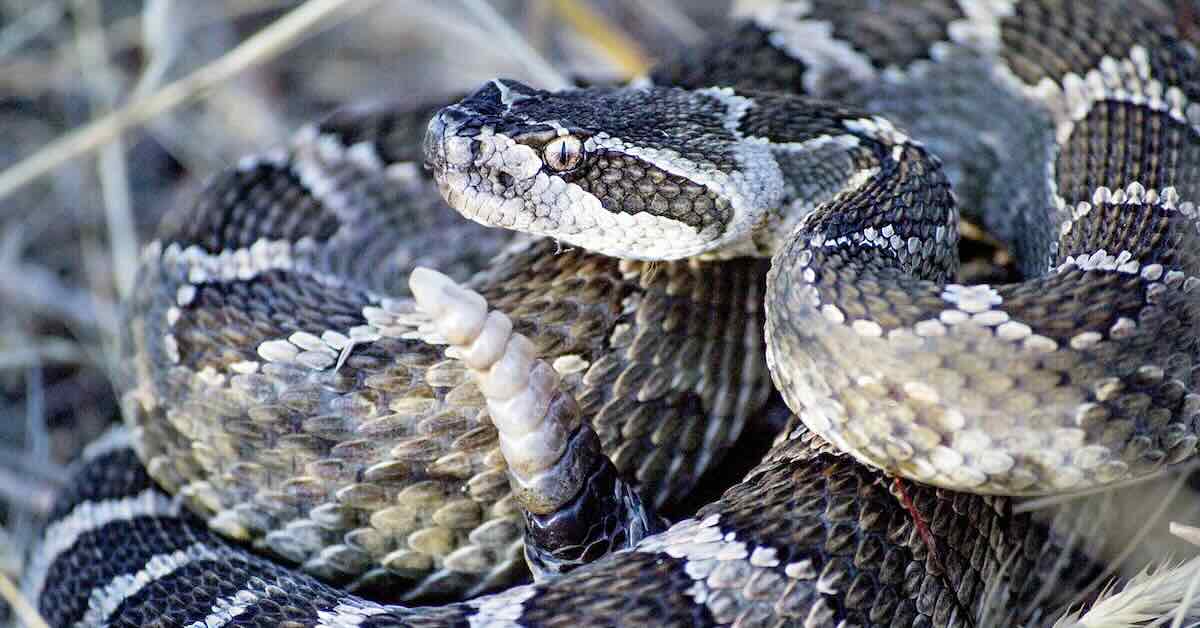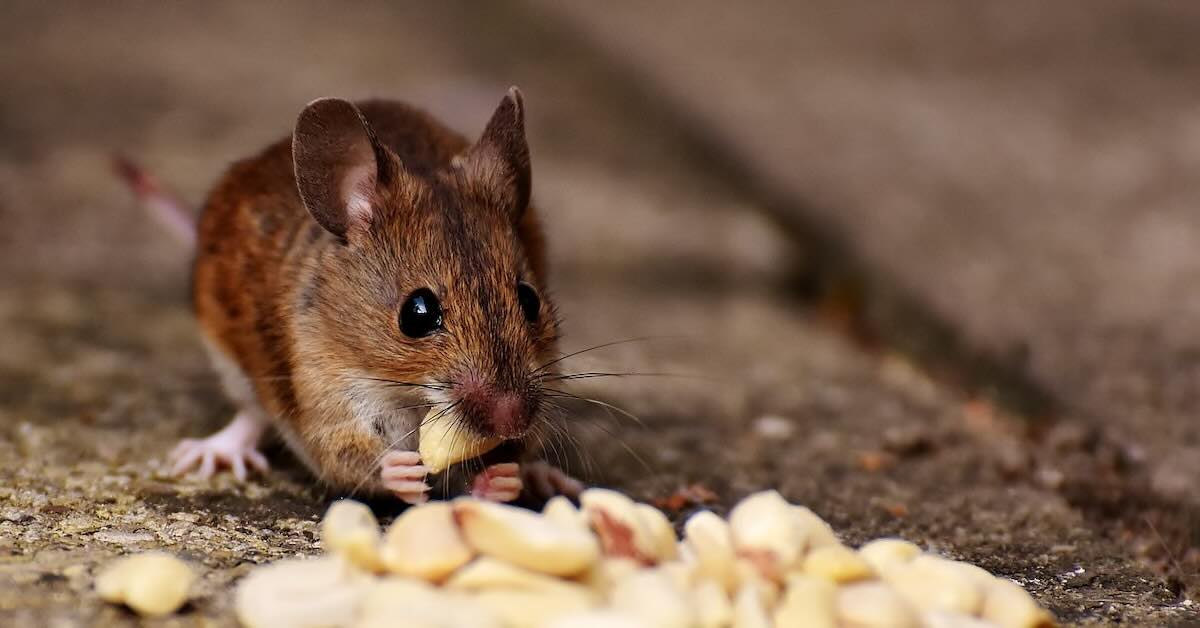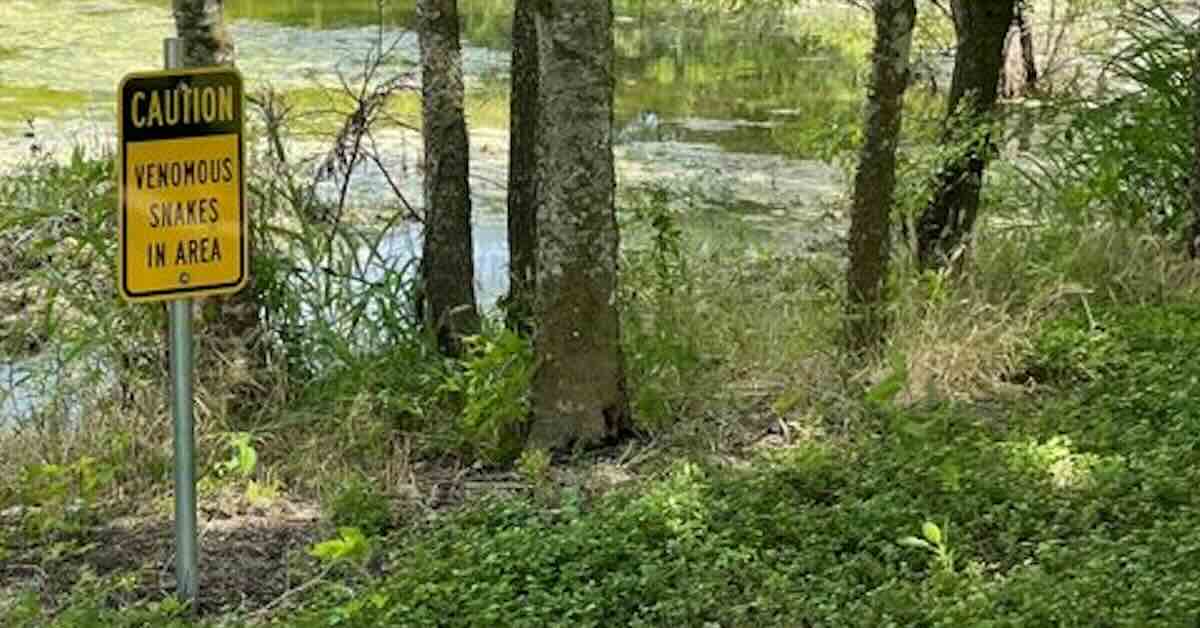While on a work trip in central Pennsylvania, I unwittingly walked within 10 feet/three meters of an Eastern Timber Rattlesnake, a pit viper with venom that's potentially deadly to humans.
The animal was in a small clearing along the edge of a parking area coiled up next to a wrist-sized branch. Its skin color and pattern blended with the oak leaves and pine needles. The snake never moved or rattled as I trundled by. At this point, the crew had been in the woods for almost a week and had never seen any snakes. After we spotted the rattler, a radio call went out to tell everyone on the team to come take a look. It would help us identify them during the remainder of the trip.

We were all pretty sure this wasn't the first near miss, but we never saw another snake during that project.
As a disc golfer, I often find myself in environments similar to where I spotted that rattler years ago (some disc golfers even actively seek out snakes). And despite decades of snake study stemming from a fascination that started in grade school, I admit that spying these slithering creatures outside of a domestic setting (i.e., in the wild and not as pets) makes my skin all tingly for an instant.
Luckily, my familiarity with snakes helps me overcome my body's visceral discomfort and see the meet-ups as the rare gifts that they are. It also gives me an understanding of snakes' favored habitats and triggers.
Here I've put together a variety of information about snakes that's interesting and valuable for the disc golf community.
Post Navigation
Click or tap below to jump to the topic that interests you most:
- How likely are disc golfers to suffer a snake bite?
- Where and when am I likeliest to see snakes on the disc golf course?
- What should I do if I see a snake while disc golfing?
- What if a snake is near my disc golf disc?
- What if I'm bitten by a snake while playing disc golf?
How Likely Are Disc Golfers to Suffer a Snake Bite?
Disc golfers tend to be in snake habitats more than the average person, but they're still very unlikely to be bitten by a snake. That's because snake bites are simply rare occurrences in the United States – and deaths from snake bites are even rarer.
Here's what a publication from the University of Florida's Department of Wildlife Ecology and Conservation says about the odds:
The chances of dying from a venomous snakebite in the United States is nearly zero because we have available, high-quality medical care in the U.S. Fewer than one in 37,500 people are bitten by venomous snakes in the U.S. each year (7-8,000 bites per year), and only one in 50 million people will die from snakebite (5-6 fatalities per year). Did you know that you are nine times more likely to die from being struck by lightning than to die of venomous snakebite?

One reason deadly bites are so rare in the U.S. is that, out of around 100 native snake species, only 22 are venomous. The only states without a native venomous species are Hawaii, Maine, Rhode Island, and Alaska – with Alaska being the only state that has no native snakes at all.
Another reason is that, despite popular lore, snakes simply aren't interested in attacking us. They will strike when surprised and/or when they feel threatened, but most species prefer flight over fight.
Return to navigation
Where and When Am I Likeliest to See Snakes on the Disc Golf Course?
Though the habits of snakes are as varied as the animals themselves, there are some places and times that disc golfers are more likely to encounter them than others:
- Near trash cans, tee boxes, and picnic areas
These are places where there's often an abundance of leftover food (bits of sandwiches, apple cores, etc.), and they attract snakes. This isn't because snakes are interested in the remnants of chicken teriyaki subs but because the scraps and crumbs draw tasty, tasty rodents. Keep a sharper eye out for snakes in these areas and, if you'd like to help others avoid encounters, be considerate about the disposal of your own pre-, mid-, and post-round snacks. - In shady, cool areas during the heat of the day
Snakes are cold-blooded, so they can't thermoregulate internally. Instead, they use the environment to keep their body temperature within the optimal metabolic range of 70-90° F/21-32° C. Snakes tend to hide from the direct sun. They will seek cool spots which can be found in piles of rocks, damp areas (the evaporating water cools the immediate area) such as forest litter (fallen logs, leaves, etc.), shaded areas of thick vegetative growth, and underground. - On warm surfaces from late afternoon until sundown
As the sun dips and the air cools, snakes seek warm, sun-baked ground or rocks that retain the sun's heat. This period is the time you're most likely to encounter a snake in a more open area (like a fairway or path between tees).

Of course, your region may have specific snakes and habitats that don't quite fit what's above. If you'd like to dive a little deeper into the typical behaviors of snakes in your area,USA Snakes is a great resource.
Return to navigation
What Should I Do If I See a Snake While Disc Golfing?
If you notice a snake at a distance while playing a round or out for a walk, consider yourself fortunate. Though they can't "hear" as we think of it, they typically slither off when their thin and ultra-sensitive ribs – sometimes hundreds of them – sense the vibrations our big feet make lumbering toward them.
And snakes that don't slide away are often nearly impossible to see as they're masters of camouflage when they remain still.
All that said, if you do spot a snake, make sure to give it a wide berth. Snakes don't see well and can't distinguish between a human and a large predator. If you approach a snake and it feels like it can't escape, the interaction could result in the snake striking out as a last resort for defense.
Even if you're interested in observing the snake, keep your distance as getting close might chase it away.
Lastly, don't antagonize or hurt the snake. Along with inviting a defensive reaction from it, you'd be doing a disservice to the disc golf community. Snakes keep rodent populations in check, and rodents carry ticks that propagate Lyme disease, which has affected many more disc golfers than snake-related injuries.
Return to navigation
What If a Snake is Near My Disc Golf Disc?
If your disc is near a snake, a disc retriever or a very long stick is a good choice for grabbing the disc (not poking at the snake). Most likely all the hubbub of retrieving the disc will upset the snake and it'll slink off and hide.
No matter how docile a snake seems, don't try to get the disc with your hand. Put yourself in its scales and imagine how you'd feel if you were sunning yourself on a rock after a cold night and a plastic flying saucer over half your size (at least) crashed down near you. Then, just a short time later, a giant creature started heading your way. It's a good bet you'd be on edge and easily startled into defensive action.
Only where we have hands and feet to lash out with, snakes just have mouths.

Even if you don't see a snake but know your disc is in a likely snake hangout – snuggled up to stacks of logs or piles of rocks – go slow and look around to be sure the area is snake free before reaching to snag the disc. You could even be extra cautious and use a retrieving stick. The same goes when discs are at the edges of watercourses.
Return to navigation
What If I'm Bitten by a Snake While Playing Disc Golf?
Should you be one of the extremely unlucky few who suffer a snake bite, here are generally recommended steps to take:
- Move away from the snake as quickly as possible.
Getting out of the snake's range will help you avoid multiple tags. - Call 911.
Though an ambulance ride may seem excessive, expensive, or embarrassing, a crew of paramedics will have the skills to keep you alive on the way to the hospital in the case of an adverse reaction like anaphylaxis. - Remove rings, bracelets, and any other snug fitting accessories or clothing.
There is a really good chance your body will react to the venom by swelling up. - Do your best to remain calm and don't exert yourself more than necessary.
An elevated heart rate can make venom spread more quickly through the body. If you're playing with a group, it's also a good idea to have someone else carry your bag. Once you're in a place where help can reach you, sit or lie down in a position where the bite area is neutral and comfortable. - If at all possible, don't get left alone.
If someone must leave the area to meet the ambulance, find cell coverage, or get something from a car, find someone to stay with you.
Keep in mind that even if you're 100% certain the snake was not venomous, it's a good idea to go to the doctor. The mouth of a snake is filthy and full of bacteria capable of causing severe localized and potentially systemic infections.
Along with all the things you should do following a snake bite, there are some you shouldn't:
- Don't do anything you've seen in movies.
Cutting little Xs across the fang marks and sucking out the venom, using a tourniquet, and/or drinking half a bottle of whiskey (or use of any other intoxicants) won't reduce the potential of death and can actually harm more than help. In fact, both alcohol andcaffeine can make venom spread faster through the body. - Don't try to cool the wound with ice or anything else.
This can make the toxins gather and cause a lot of tissue damage. - "Do not take pain relievers (such as aspirin, ibuprofen, naproxen)"
A direct quote from CDC guidelines on snake bites
Return to navigation
Cold-Blooded but Not Killers
Like I've emphasized already, snakes are not out to get humans. We're not on their menu, and they won't bother us unless we bother them. By following the precautions outlined above, you'll lower your already tiny chance of suffering a violent encounter with a snake while playing disc golf to nearly zero.
As predators of rodents that bear disease-carrying parasites, snakes are much more like our friends than our foes. Yes, they're weird and scary, but as long as we treat them and their habitats with respect, they're beneficial to us in the long run.